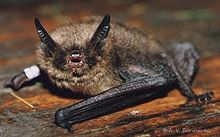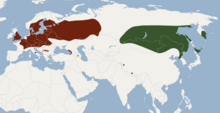Brandt's bat
| Brandt's bat | |
|---|---|

| |
| Scientific classification | |
| Domain: | Eukaryota |
| Kingdom: | Animalia |
| Phylum: | Chordata |
| Class: | Mammalia |
| Order: | Chiroptera |
| Family: | Vespertilionidae |
| Genus: | Myotis |
| Species: | M. brandtii
|
| Binomial name | |
| Myotis brandtii (Eversmann, 1845)
| |

| |
| Myotis brandtii range in red | |
| Synonyms | |
| |
Brandt's bat or Brandt's myotis (Myotis brandtii) is a species of
Taxonomy and etymology
The species was described in 1845 by German zoologist Eduard Friedrich Eversmann, who placed it the genus Vespertilio.[2] For a time, the Brandt's bat was considered a subspecies of the whiskered bat, Myotis mystacinus. In 1958, one author proposed that the two might be separate species, based on baculum differences; this idea gained traction in papers authored in 1970 and 1971.[3] It is named for the German zoologist Johann Friedrich von Brandt.[4]
Formerly, populations in central and eastern Asia were classified in this species. However, more recent studies indicate that they form a distinct species, the Siberian bat (Myotis sibiricus).[5]
Range and habitat
It is found throughout Europe and western Asia, and can be found in the following regions: Great Britain, Western Europe, Central Europe, Fennoscandia, and western Russia.[1] In the Balkans it is limited to the mountains.[6] In 2010, Brandt's bat was documented in Ireland for the first time.[7] Throughout its range, it has been documented at elevations from 0–1,800 m (0–5,906 ft) above sea level. It can be found in deciduous forests, or forests that are a mix of deciduous and coniferous trees. It is often found in close proximity to water.[1]
Description
It has dark gray or brown fur that is grayish underneath with golden tips. The face and the tips of ears are pinkish in color.[8]
Biology

Like primates and other bats, the Brandt's bat has lost the ability to synthesize vitamin C.[9]
Reproduction
During the summer, females will form
Longevity
Brandt's bats had previously been reported to have very long lifespans nearing 40 years, but these populations have since been reclassified into a different species, the
Senses
Like other
Conservation
It is currently evaluated as
References
- ^ a b c d e Gazaryan, S.; Kruskop, S.V.; Godlevska, L. (2021) [errata version of 2020 assessment]. "Myotis brandtii". IUCN Red List of Threatened Species. 2020: e.T85566997A195857637. Retrieved 18 April 2021.
- ^ Eversmann, E. F. (1845). Vespertiliones in promontoriis Uralensibus tractibusque confinibus observati. Moscow: Bulletin de la Société impériale des naturalistes de Moscou. pp. 18–21.
- .
- ISBN 978-0801895333.
- ^ ISSN 1508-1109.
- ^ Myotis brandtii - Science for Nature Foundation
- S2CID 83910263.
- ^ a b c "Brandt's bat" (PDF). bats.org. Bat Conservation Trust. 2010. Archived from the original (PDF) on November 15, 2017. Retrieved November 9, 2017.
- ^ PMID 23962925.
- ^ ISSN 1079-5006.
- PMID 10934005.
- S2CID 86180828.
- ^ "What are European Protected Species?". Biodiversity Planning Toolkit. Association of Local Government Ecologists (ALGE). 2011. Retrieved November 10, 2017.
External links
- ARkive Photographs

